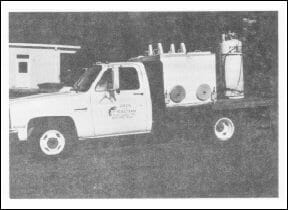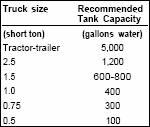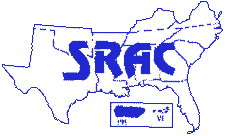Equipment and Guidelines
Most fish losses from hauling are the result of the activation of latent disease organisms or osmoregulatory problems. Poor water quality, overcrowding and improper tempering cause serious fish losses. The ultimate goal is to provide healthy fish that survive after stocking.
Water quality
Water quality is an important factor to manage while fish are crowded and stressed in hauling. The major parameters that limit the loading density of fish are adequate oxygen levels and buildup of toxic waste products such as ammonia and carbon dioxide. Temperature, pH, loading density and trip duration affect the severity of these problems. A suitable water supply is needed for short-term holding and hauling. Cool, uncontaminated well water is preferred. Oxygenate well water thoroughly before it is used in the transport tank to remove carbon dioxide and add dissolved oxygen. Beware of high levels of ammonia and iron that can occur in well water. Ammonia can be removed by aging water in a tank, and iron can be removed by aerating water before use. Pond water is less desirable because it often has a heavy algae bloom and other organisms that remove oxygen from the water and produce ammonia as a waste product. Pond water also is more likely to have harmful fish pathogens than well or spring water. Clear pond water without a heavy algae bloom can be used for short trips. Special care is needed when any surface water is used to make sure that no harmful contaminants are present.
Fish condition
 Custom designed transport truck using liquid oxygen for aeration. Note size of discharge opening for large fish and side location of drain. |
One critical factor to the successful handling and transport of fish is that fish be healthy and in good condition before they are hauled. Another important consideration is the variability of tolerance to loading and transport stress among species. Some species are very hardy while others require special precautions. With so many variables important in transporting fish, it is imperative that the hauler is knowledgeable about acceptable loading rates for the specific conditions. Start with a safe loading rate, and increase later based on experience and results.
Hauling tank systems
The hauling unit should be compatible with its intended use. A light pickup can handle a 100- gallon tank while a 3/4 ton pickup can pull a gooseneck trailer with two 350-gallon tanks. Water is heavy--one gallon weighs 8.3 pounds. Some units are attached to the frames or flatbed of trucks. Other units are portable and can be lifted manually or with a winch and/or pulleys. Gooseneck trailers with electric brakes are also used to carry transport tanks. The pickup truck used to pull the gooseneck is then available for other farm work. Specially designed self-contained transport vehicles are common in situations where they are used regularly to haul large quantities of fish. A producer can save money by purchasing used equipment in good condition. Follow recommended gross weight limits for vehicles and tonnage weight of the trailer for safety reasons.
 Typical long-haul truck delivery system utilizing blowers and oxygen. This tractor-trailer rig with transport tanks in series can haul large quantities of fish. |
In the South, most hauling tanks are insulated unless trips are short or tanks are for on-farm use only. Insulation means little or no ice is required to maintain temperatures on long trips. Urethane foam, plastic foam and corkboard are common insulating materials used as filler between tank walls. Tank capacities range from 75 gallons to 2,500 gallons with the most common tanks holding 100 to 300 gallons. Tank depth is usually 28 inches to 32 inches. Most tanks are rectangular and may have from one to eight compartments with varying arrangements.
More than one compartment is needed if several fish sizes or species require transport at the same time. Large or long tanks must contain baffles to reduce water sloshing that can injure fish and create dangerous driving conditions. Welds in single, long tanks may break if the truck bed warps. This can be avoided if smaller, standard tanks with the same carrying capacity are placed side by side. Most tanks are made of 3/16-inch aluminum or l/4-inch thick fiberglass. Uninsulated fiberglass or marine plywood tanks work well for short trips. Metal tanks are less likely to be broken or damaged. Any hardware on the tank should be aluminum, stainless steel or other rust-resistant material. The top doors or lids of the tank should be large if fish will be loaded with a boom and fish basket.
Large doors make fish removal easier if dip netting is required. The tank drain can be located either in the rear or side of the tank. Side outlets allow easy unloading of fish to holding vats or ponds by means of chutes or extended discharge pipes. These reduce rough handling caused by dip-netting. The discharge opening should be large enough to easily pass the largest fish hauled and should be equipped with a quick release gate or plug.
Drain openings can be rectangular or round with round drains usually 3 to 8 inches in diameter. These may be controlled with inside rubber stoppers, outside expansion plugs or threaded caps. A sliding inside gate, over the drain opening, is useful to control the rate of discharge and permit removal of outside cap or plug without releasing water or fish.
A sloped false bottom permits the complete discharge of water and fish with minimal extra handling. The bottom of the drain opening should be flush with the tank bottom. A lip on this drain prevents total emptying of water and fish. Tanks should be equipped with an overflow drain to maintain water level and allow agitators to function at the proper operating depth. Electrical outlet boxes should be available for easy hookup of agitators. A central junction box with wires leading to individual outlets works well.
Another feature is an air vent or scoop to permit air circulation in the space between the water surface and tank top. Adequate ventilation is important especially on long trips, to reduce accumulation of carbon dioxide. Although uncommon in the South, tanks may have clear, vertical tubes or panels for determining fish weights by calibrated water displacement rather than by scale weighing. This method requires that water transfer with fish be minimized. It is commonly used in the trout industry where fish pumps and dewatering towers are used to move fish from production or holding units to transport tanks. Handling is minimal and efficient.
Aeration systems
A variety of methods can aerate water during hauling. Because fish are densely crowded and excited-- especially after loading--it is essential to have an aeration system that provides adequate dissolved oxygen (DO) rapidly and efficiently. For most cases, maintain oxygen concentrations above 6 parts per million (ppm) at all times. Higher oxygen levels, near air saturation, may lessen the effects of any ammonia buildup, especially on long trips.
Most hauling units today use some form of pure oxygen. Most are equipped with compressed oxygen tanks but some haulers use liquid oxygen (LOX) because it is cheaper, weighs less, and fewer tanks supply the same amount of oxygen. A standard oxygen cylinder holds about 280 cubic feet of oxygen and weighs about 150 pounds. A LOX dewar (tank) holds about 4,500 cubic feet of oxygen and weighs about 780 pounds. Other sizes of oxygen cylinders also are available. Follow all recommended safety precautions when near pure oxygen.
Both kinds of oxygen tanks can be leased or purchased. A LOX dewar is more expensive. LOX is cheaper per cubic foot of oxygen than compressed oxygen in most locations. For small fish loads and short trips, compressed oxygen is adequate. Consider cost, needs, service and convenience in deciding which oxygen source to use. Also, liquid oxygen should not be stored for long periods because of gas losses through pressure release valves at the rate of about 2 percent daily. Compressed oxygen can be stored indefinitely. Single stage pressure regulators are needed for each oxygen tank, and each aeration line to a tank compartment should have a flow meter (lpm) to adjust supply rates.
Various diffusers are used for dispersing oxygen from the bottom of the tank compartment. Carbon stones or rods, MicroporeTM tubing, BioweaveTM, PorexTM, and others work well. Aeration lines from the regulator to flow meters and drop lines to the diffusers are usually 3/8-inch ID flexible plastic tubing or PVC pipe. Some diffusers are made of PVC frames that fit the bottom of the tank compartment.
Agitators are commonly used either alone or in combination with pure oxygen. Agitators can also provide back-up aeration for emergency situations. For short trips agitators alone may suffice The combination of agitators with oxygen diffusers works well for fish hauling. Agitators do not have good mixing characteristics alone, and low DO may result in corners of the hauling tank. Oxygen diffusers do not remove carbon dioxide efficiently because of minor agitation at the water surface, but under the high density hauling conditions, they supply oxygen efficiently. Most agitators are 12-volt direct current (DC) units powered by the vehicle’s battery and alternator. Alternators should be heavy-duty, and the vehicle’s engine should be kept running during a short stop to keep the battery charged. One agitator per compartment is used. Excessive agitation can be harmful to delicate scaled fish, and diffused oxygen is preferred for small fish.
Other equipment and supplies
To assure the successful delivery of fish, other additional equipment and supplies are recommended. If you sell fish in many small lots along a route, an easily attached or extendable support for a hanging scale is useful. The scale should be in pounds and ounces and have a weighing bucket. You will need a suitable dip net to transfer fish. An oxygen meter or test kit is important for measuring oxygen concentrations in transport and receiving waters. Oxygen levels and water temperature can be monitored easily by using an oxygen meter with a long cable attached to the probe.
Gauges and manifolds that indicate the functional status of agitators and flow meters can be put inside the truck cabin. Flow meters may also be located or oriented for easy visual inspection to make certain oxygen is supplied at all times during the trip. Water hardness, alkalinity and pH test kits should be used to check transport and receiving waters, especially if fish are removed from hard, highly alkaline water to soft, acid water with low alkalinity. If you deliver fish to sites where chlorinated water is used, a chlorine test kit is helpful. Sodium thiosulfate may be needed to dechlorinate water.
Carry at least one extra agitator and other essential spare parts, like fittings and hoses, at all times. A 12-volt submergible pump or gasoline-engine pump is useful for adding water in an emergency or for tempering fish by pumping pond water at the stocking site into the transport unit to exchange the water slowly and avoid any shock from temperature or water quality differences.
Pre-hauling handling and planning
Fish must be in good health and good condition before they are loaded into transport units. Fish in poor condition may die during transport or suffer delayed death after stocking. Withhold food from fish for at least 1 to 2 days before transport during warmer months and 3 days or longer during colder weather.
Fish with empty stomachs are hardier, will not regurgitate food in the transport unit and will produce less metabolic waste. Do not starve cannibalistic fish such as striped bass or red drum longer than 3 days before harvest. If possible, use V-traps or harvest basins in ponds to harvest small, delicate, scaled fish. For larger fish, harvest as many as possible by seining or trapping as water level is lowered. Select the proper mesh size and net material for harvest seines and dip nets to avoid injuring or gilling fish. Purchase treated nylon nets or treat with a net coating for seining catfish. Use soft 3/16- inch knotless nylon mesh nets for delicate minnows.
Polyethylene nets do not require special treatment. After fish are harvested, carefully remove debris and give fish a resting period of several hours before they are handled again. If holding vats are available, you can easily grade, clean and sort fish prior to shipment. Then the fish may be slowly tempered or acclimated to the expected transport water temperature. If fish are to be held in ponds, maintain adequate aeration and water quality. Secure live cars or harvesting seines to the pond bottom. Avoid holding large fish or active species in cages. Do not overload cages. If fish begin to die, diagnose the problem, then treat and return fish to the pond rather than transport them. Prophylactic treatment with approved chemicals can reduce pathogenic organisms that could cause problems during or after transport. Paracide-F maybe used in holding vats for 15- minute to l-hour baths.  Avoid overtreating with excessive doses or combinations of chemicals. Be prepared to flush any treatment with fresh water if fish show any signs of stress. The transport unit and equipment, such as dip nets, should be dried and disinfected between loads of fish. This practice reduces the possibility of spreading disease pathogens from one group of fish to another. Tanks can be thoroughly air-dried or treated with chlorine in a 10 ppm solution for an hour. Household bleach (5 percent chlorine) or HTH (65 percent chlorine) can be used. Flush tanks thoroughly after chlorine treatment. A 5 percent solution of formalin can also be used to disinfect.
Avoid overtreating with excessive doses or combinations of chemicals. Be prepared to flush any treatment with fresh water if fish show any signs of stress. The transport unit and equipment, such as dip nets, should be dried and disinfected between loads of fish. This practice reduces the possibility of spreading disease pathogens from one group of fish to another. Tanks can be thoroughly air-dried or treated with chlorine in a 10 ppm solution for an hour. Household bleach (5 percent chlorine) or HTH (65 percent chlorine) can be used. Flush tanks thoroughly after chlorine treatment. A 5 percent solution of formalin can also be used to disinfect.
To avoid untimely delays, get good directions to your destination. Plan your trip to include any drop-offs or water refreshening. Be certain that all required permits or licenses are in order and carried in the vehicle in case of an inspection check. Some states require special markings on fish transport trucks. Check with the proper regulatory authorities for current information on laws and regulations on transporting and marketing live fish before doing interstate business. The following table provides information on matching truck sizes with fish hauling tanks of various capacities.
June 1990


